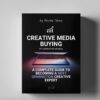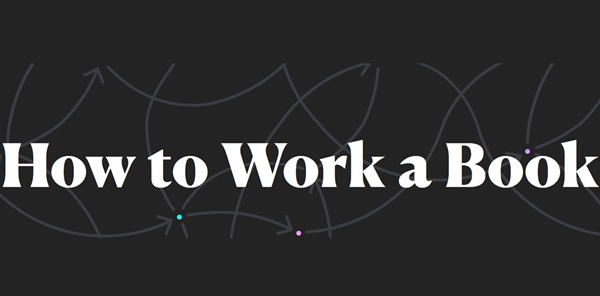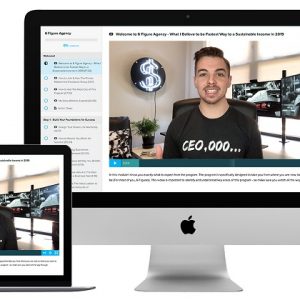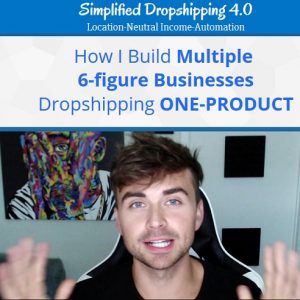No products in the cart.
How to Work a Book – Nick Milo
$99.00 $19.00
- Payment method: I will send the payment link to your email.
- Deliver by: Google Drive, Mega.nz
Category: Marketing
How to Work a Book represents a profound shift in how individuals engage with non-fiction literature, moving beyond the traditional passive act of reading to an active, dynamic process designed for deeper understanding, retention, and practical application. This transformative approach redefines the relationship between reader and text, positioning books not as mere sources of information, but as catalysts for developing one’s own thought and knowledge.
Table of Contents
How to Work a Book
The methodology encapsulated within the concept of How to Work a Book promises a revolution in learning, condensing years of passive reading into a concise, powerful two-hour intensive session. It posits that true learning from non-fiction stems from an active engagement, an iterative dance with the material that builds context, unearths actionable insights, and embeds knowledge for lasting impact. This is not about reading more quickly, but about reading more deeply and effectively, turning fleeting impressions into durable understanding and actionable wisdom.
Beyond Passive Consumption – The Book as a Tool for Thought
A foundational tenet of the How to Work a Book philosophy challenges what is arguably the most detrimental misconception about books: that they are linear narratives to be absorbed front-to-back, much like a novel. This conventional approach, while suitable for fiction, fundamentally hobbles the non-fiction reader, often leading to superficial understanding, rapid forgetting, and a missed opportunity for true intellectual growth. The program champions a paradigm shift, urging participants to view The Book as a Tool for Thought. This reorientation is not merely semantic; it demands a different kind of interaction, one where the reader actively manipulates, questions, and synthesizes the material rather than merely receiving it.
This shift profoundly redefines the act of note-taking, elevating it from simple highlighting – often an unproductive act of merely marking text without deeper engagement – to genuine note-making. Note-making, in this context, is an active cognitive process where the reader interacts with the text, drawing connections, formulating questions, and articulating personal insights that emerge from the material. It’s about using the book as a springboard for one’s own intellectual development, allowing the ideas within to catalyze new thoughts and perspectives.
Instead of simply reflecting what the author wrote, the reader uses the book to clarify and refine their own thinking. This active intellectual collaboration transforms the reading experience, ensuring that engagement leads to demonstrable personal and intellectual growth. The goal is not just to understand what the author said, but to integrate it into one’s existing mental models, thereby expanding and refining them in a truly meaningful way that transcends the fleeting details of specific pages.
The very essence of How to Work a Book lies in this foundational mind-shift. It recognizes that to truly benefit from a non-fiction text, one must approach it with an intention to actively engage, extract, and apply, rather than passively consume. This distinction is critical for anyone who seeks to leverage books as instruments for personal and professional development. Without this initial re-framing, even the most sophisticated note-taking tools or techniques will fall short, as the underlying mindset remains rooted in a less effective mode of interaction. This active approach liberates the reader from the tyranny of needing to “finish” every book or understand every sentence, instead focusing on what is most resonant and relevant to their individual journey of inquiry and learning. The book becomes a dynamic partner in a dialogue, rather than a static artifact to be revered from a distance.
The Art of Context and Emergent Inquiry
Central to the effectiveness of How to Work a Book is its relentless focus on building robust context around a text before diving deep. The concept of Rapid Context-Building is introduced as a cornerstone, designed to help users “learn, apply, and remember what you read better than ever before.” This isn’t just about reading the introduction; it involves deliberately seeking out the “story behind the book,” leveraging often “hidden elements” that contextualize the author’s intent, the book’s place in intellectual discourse, or the core problems it seeks to solve. Imagine understanding the architect’s vision before exploring a building; similarly, understanding the intellectual landscape a book inhabits allows for a much richer, more informed engagement with its content.
The program introduces the compelling metaphor of “LiDAR for Books” to illustrate this process. Just as LiDAR technology creates a precise three-dimensional map of its environment, this method encourages readers to “Create a depth map of the book to dive into the most resonant material first.” This strategic approach is encapsulated in the adage, “They who make a better map, make a better mark!” By quickly identifying the book’s core arguments, structure, and most valuable sections, readers can prioritize their attention, ensuring that their limited time is spent on material that offers the highest return on investment.
This contrasts sharply with the inefficient, linear front-to-back reading that often buries critical insights under less relevant details. The initial mapping phase is a dynamic exploration, a pre-reading “scouting mission” that prepares the mind for targeted engagement, preventing the reader from getting lost in the weeds and instead directing them to the prime intellectual landscapes within the book.
This mapping process naturally leads to an active, iterative approach that vehemently discourages passive, linear reading. Instead, How to Work a Book promotes emergent learning, where reading itself becomes a catalyst for further exploration and inquiry. The “1 Meta Question” serves as a powerful anchor, a central query that reshapes the interaction with every book, guiding the reader’s focus and acting as a filter for relevant information.
From this meta-question, “Emergent Questions & Emergent Answers” naturally arise, highlighting “the art of engaging with a book (allowing your exploration to be the catalyst to drive your next steps).” This dynamic process embraces curiosity as a driver, where each piece of information uncovered can spark new questions, leading the reader down an organic path of discovery customized to their evolving understanding. Furthermore, the counter-intuitive advice to “Have Dessert First” addresses the common hurdle of reading difficulty.
It suggests starting with more engaging or immediately rewarding material to make the process “fun’ on demand,” thereby building momentum and intrinsic motivation before tackling potentially denser sections. This intuitive understanding of human psychology, combined with the structured context-building, cultivates a truly personalized and effective learning journey where curiosity is paramount, and the destination is not merely comprehension, but profound insight.
From Comprehension to Lasting Application
The ultimate aim of How to Work a Book extends far beyond simply understanding the concepts presented in a non-fiction text; it is profoundly focused on enabling practical application and ensuring long-term retention. Many readers experience the frustration of finishing a book, feeling enlightened, only to find the insights fade within weeks or even days. This program systematically addresses that Achilles’ heel of learning, transforming passive comprehension into actionable outcomes and enduring knowledge. It’s about building a robust bridge from the page to real-world impact, ensuring that the time invested in reading translates directly into enhanced capability and wisdom.
Several learning points within the methodology are meticulously designed to facilitate this transformation. One such critical technique is “Articulating Insights,” described as “the simplest way to transform sparks you read into remarks you remember.” This goes beyond just summarizing; it involves rephrasing, connecting, and explaining a concept in one’s own words, solidifying it in memory and preparing it for recall and application.
The act of articulation, whether spoken or written, forces a deeper processing of the information, moving it from the realm of fleeting recognition to embedded understanding. Similarly, “Planting Compelling Concepts” is introduced as “the simplest way to build your knowledge.” This involves intentionally integrating new, powerful ideas into one’s existing knowledge framework, creating mental hooks that make the concepts readily accessible for future use. It’s about conscious knowledge construction, not just passive accumulation, turning isolated facts into a rich, interconnected web of understanding that serves as a foundation for future learning.
Perhaps the most direct attack on the common problem of non-application is “Applying Actionable Ideas,” framed as “the simplest way to actually apply something actionable from the books you read.” This principle insists on identifying specific steps or changes that can be implemented based on the book’s teachings, and then acting on them. It closes the loop between theory and practice, ensuring that insights don’t remain abstract but translate into tangible changes in behavior, strategy, or perspective.
Finally, the program advocates for “Embodied Learning,” leveraging the powerful idea “that we learn better when our bodies are involved to enhance retention and understanding.” This might involve active retrieval practice while walking, discussing concepts with gestures, or even physically mapping out ideas. Engaging multiple senses and dimensions of cognitive processing strengthens neural pathways, making insights Stickier and more readily available for recall under various conditions.
The very design of this program and its emphasis on application naturally defines its target audience. It is specifically for individuals who “want to confidently apply what you learn from what you read,” those who “want to achieve better levels of understanding, more efficiently, and more enjoyably,” and especially those who “struggle with dread or guilt about reading more from a book.” It caters to those who find note-taking “devoid of fun and often overwhelming but desire a better way,” and who “want to remember and articulate takeaways from books, even months or years later.” Crucially, it is also for those “overwhelmed by processing highlights or have trouble focusing.”
Conversely, the program explicitly states who it is not for: “One-way readers who insist on reading front-to-back,” “Fiction optimizers” (as linear reading is generally preferred for fiction), “Integration magicians focused on tool integrations,” and “Misguided highlighters who engage in overly complex, rigid summarizing workflows.” This clear demarcation highlights its specialized, highly practical approach. Ultimately, How to Work a Book is a framework that empowers individuals to transform their relationship with non-fiction, turning every book into a powerful lever for personal and intellectual advancement, ensuring that knowledge is not merely consumed but truly owned and applied.
Nick Milo
While the “Briefing Document” focuses on the program Change Your Reading Habits: Work a Book Better, the inclusion of Nick Milo’s name as a specific keyword for this article implies his significant influence, if not direct authorship, of the methodology. It suggests that Nick Milo is seen as the visionary or thought leader behind this transformative approach to non-fiction reading. His work, therefore, is not merely about a set of techniques but embodies a philosophy that challenges conventional reading habits and offers a more robust, integrated path to knowledge acquisition and application. It speaks to a concerted effort to create a paradigm where readers are empowered to become active knowledge workers, rather than passive recipients.
The Visionary Behind Transformed Reading
Nick Milo emerges as a driving force behind a revolutionary approach to interacting with non-fiction books, advocating for a profound understanding of what a book truly represents. He appears to be the proponent of challenging the widespread “most-harmful misunderstanding about books,” which stems from the ingrained habit of treating every book like a novel—a linear narrative to be consumed sequentially.
Instead, Nick Milo champions the bold and liberating concept of The Book as a Tool for Thought. This is not a casual suggestion but a core philosophical re-evaluation that underpins the entire How to Work a Book methodology. By reframing the book not just as a source of information but as an instrument to sharpen one’s own intellect and explore one’s own ideas, Nick Milo invites readers into a dynamic, co-creative process.
This visionary stance is deeply rooted in the recognition of a common problem: readers invest countless hours in non-fiction, yet often struggle to retain, recall, or apply what they’ve learned. Nick Milo’s commitment is to rectify this inefficiency, offering a pathway to revolutionize engagement with complex texts. The bold claim that How to Work a Book represents “the best two hours you can spend with any book you want to read” is not merely marketing hyperbole; it’s a testament to the belief that focused, intentional engagement, guided by a robust framework, can yield exponentially greater returns than unstructured, passive consumption. This speaks to a belief in the power of metacognition and structured learning, demonstrating immense confidence in the efficacy of his prescribed methods.
The impact of such a philosophy, propagated by an individual like Nick Milo, extends far beyond simple reading techniques; it fundamentally redefines the pedagogical landscape for self-learners and knowledge workers alike. His vision empowers individuals to take ownership of their learning journey, transforming a potentially overwhelming and often fruitless endeavor into an enjoyable and highly productive one.
It’s a call to action for anyone who has ever felt the guilt of an unread book on their shelf or the frustration of insights that vanished too quickly. By providing a clear, actionable framework, Nick Milo is not just teaching how to read; he’s teaching how to learn, how to build a lasting relationship with knowledge that continuously fuels personal and professional growth. This approach suggests a commitment to empowering individuals with skills that transcend the digital tools or platforms, focusing on the cognitive architecture required for true intellectual mastery.
Architecting Knowledge for Deeper Understanding
The core tenets of the How to Work a Book approach, deeply influenced by Nick Milo’s presumed pedagogical insights, revolve around the systematic yet flexible architecture of knowledge building. Concepts like “Rapid Context-Building,” “LiDAR for Books,” and the creation of a “depth map” are not just clever metaphors; they signify a methodological rigor, indicative of a mind focused on information organization and knowledge management.
It suggests Nick Milo understands that haphazard reading leads to fragmented knowledge, whereas intentional structuring, even before deep engagement, lays a robust foundation for profound comprehension. This pre-reading “scouting mission” serves as a strategic aerial view, allowing the learner to identify key landmarks and optimal paths before embarking on the detailed ground exploration. This foresight dramatically enhances efficiency and ensures that subsequent efforts are directed precisely where they will yield the most significant intellectual dividends.
This architectural mindset is further evident in the emphasis on “The 1 Meta Question” and fostering “Emergent Inquiry.” These are sophisticated techniques that move beyond superficial comprehension, guiding the reader to actively construct their own understanding rather than merely receiving pre-packaged information. Nick Milo’s approach seems to teach a form of Socratic engagement with texts, where questions are not just answered but generated by the interaction with the material.
This dynamic interplay between reader and text transforms reading into a living, evolving process of discovery. The “1 Meta Question” acts as a beacon, focusing the reader’s attention and energy on what truly matters to them, personalizing the learning journey. The emergent questions, then, serve as organic growth points, allowing new pathways of thought to appear spontaneously, driving the reader deeper into the material’s nuances and connections to their existing knowledge base.
Moreover, the entire framework, from extracting insights to “Planting Compelling Concepts,” showcases Nick Milo’s likely expertise in what might be called “knowledge hygiene” or “intellectual carpentry.” These aren’t just one-off actions; they are part of a continuous process of refining and integrating new information into an ever-expanding, interconnected knowledge base. The emphasis on “articulating insights” and “applying actionable ideas” closes the loop, transforming raw data from books into actionable intelligence.
It speaks to a holistic understanding of how knowledge moves from passive intake to active transformation to practical implementation. This sophisticated system for active engagement implies a thorough understanding of cognitive science and effective learning strategies, ensuring that the structured yet fluid nature of How to Work a Book is built on sound principles for optimal retention and utility. The method championed by Nick Milo thus becomes a powerful tool for self-education, empowering individuals to take control of their intellectual growth and build a reliable personal knowledge system.
Cultivating a Practice of Lifelong Learning
The ultimate contribution of Nick Milo’s framework, How to Work a Book, extends beyond individual reading sessions; it aims to cultivate a sustainable practice of lifelong learning. The methods are designed not just to improve how one reads a single book, but to instill a set of habits and a mindset that transforms an individual’s entire relationship with knowledge. By empowering people to “confidently apply what you learn from what you read,” the program addresses one of the most significant barriers to effective self-education: the gap between knowing and doing. This emphasis on actionable intelligence and practical wisdom ensures that learning is not an academic exercise but a direct catalyst for personal and professional growth. The goal is to make learning an intrinsic, enjoyable, and continually rewarding endeavor, fostering intellectual curiosity that spans a lifetime.
Nick Milo’s approach aims to make the learning process itself more efficient and enjoyable, alleviating the common struggles many face. For those who “struggle with dread or guilt about reading more from a book,” or find “note-taking devoid of fun and often overwhelming,” the program offers a refreshing alternative. By re-framing engagement as an active, playful, and rewarding process — like “Have Dessert First” — it infuses intrinsic motivation back into learning. This makes intellectual exploration not a chore, but an adventure. Furthermore, the techniques for “remembering and articulating takeaways from books, even months or years later” address the pervasive issue of knowledge decay. This capability ensures that the intellectual investment of reading pays dividends far into the future, building a durable knowledge base that compounds over time.
The inclusion of “Apply Embodied Learning” within the methodology highlights a holistic understanding of how humans learn best. It acknowledges that true assimilation often involves more than just cognitive processing, integrating physical engagement to deepen understanding and retention. This comprehensive approach, championed by Nick Milo, extends beyond mere comprehension to encompass the full spectrum of learning—from initial engagement to deep internalization and lasting application. It prepares individuals to constantly learn, adapt, and apply new information in a rapidly changing world.
The program’s explicit goal for making reading “more enjoyable, efficient, and ultimately, more impactful” on one’s knowledge and actions paints a clear picture of its vision. It suggests that Nick Milo is not just offering tips and tricks, but fostering a profound and durable transformation in how individuals interact with the world of ideas, ensuring that their journey as learners is both productive and profoundly satisfying. It’s about building cognitive resilience and adaptive intelligence through continuous, active engagement with the vast ocean of human knowledge.
The provided data contains a practical requirements list which can be presented as a bulleted list:
Participants in the “Change Your Reading Habits: Work a Book Better” session are instructed to bring:
- A non-fiction book: To work through this live, together.
- A PKM, journal, or note-making tool: Such as an Obsidian template provided after the event, but the process is tool-agnostic.
- Enthusiasm: To ensure an active, non-passive learning experience.
This list succinctly captures the essential elements required for engaging with the How to Work a Book methodology, emphasizing both material preparedness and an open, active mindset.
Conclusion
How to Work a Book offers a two-hour transformative experience, an intensive session designed to revolutionize how individuals engage with, learn from, and apply non-fiction books. At its heart, it champions a fundamental paradigm shift: moving beyond passive consumption to actively perceiving The Book as a Tool for Thought. By emphasizing targeted context-building, fostering emergent inquiry driven by a meta-question, and rigorously focusing on practical application and long-term knowledge retention through techniques like articulating insights and embodied learning, How to Work a Book empowers readers to become engaged and effective learners. This powerful methodology transforms reading from a potentially overwhelming chore into an enjoyable, efficient, and ultimately, profoundly impactful journey of intellectual growth and actionable wisdom.
Sales Page:_https://www.linkingyourthinking.com/how-to-work-a-book
Be the first to review “How to Work a Book – Nick Milo” Cancel reply
Related products
$49.00
$39.00
Sale!
Marketing













Reviews
There are no reviews yet.